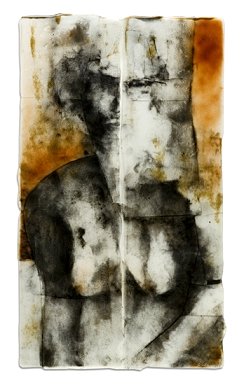GLASS QUARTERLY
Review: Jeff Wallin
at Bullseye Gallery (Portland, OR)
by Richard Speer
In his aptly titled solo show, Jeff Wallin explores the dynamic Tension between two media—charcoal on paper versus frit on glass panel—and the ways in which layering, color, and surface effects can formally and temporally decontextualize the human figure. This body of work is the product of the artist’s month-long residency in Spring 2008 at Vrij Glas studio in Zaandam, North Holland. During the residency, Wallin used frit to render live models, endeavoring to capture form and features spontaneously, without recourse to preliminary sketches. Atop the base image he layered irregular shards of clear glass, then kiln-fired the work as many as eight times, with the work face-down during its final firing to impart textural nuances onto the surface. This process and the pieced-together, irregularly edged appearance it produced, lend the finished works an antiqued feel that heightens their time-nonspecificity.At the exhibition’s entrance, a portrait called Frederick serves as a jumping-off point and basis for comparison, as Wallin completed it immediately prior to his residency. Based on his previous working method of referring to sketches rather than live models, Frederick depicts a man’s bearded face and bald pate in a chunky, austere style that contrasts with the more sensuous, painterly approach he adopted in Zaandam. To wit, Figure Study in Two Halves presents a softer, more fleshly semblance and a strong sense of directional light. The figure’s eyes, shadowed beneath a strong brow, showcase Wallin’s command of sfumato, a technique at which he excels throughout the show. The study’s vaguely Hellenistic female nude appears all the more Classical floating beneath aqueous, pieced-together planes, as if the work had been retrieved in shards from the sea floor and reconstituted for museum display. The work’s color palette, however—rich umbers and burnt siennas suggesting stains, rusts, and smudges—is more Rembrandt van Rijn than Aphrodite of Melos, which further displaces the piece’s sense of chronology and art-historical reference.
The works’ organicism comes across nowhere more clearly than in Seismic Figure Study, its fissured planes evoking not only tectonics and cracked lakebeds, but also plant cells as viewed through a microscope. Wallin’s treatment of the supple nude feels more contemporary here, like a sunlit 1970s centerfold, complete with feathered hair and the slightly oxidized tinge of magazine pages that have begun to yellow. Western Light pushes the idea of organicism in a more literal direction, with bluish-white splotches irregularly scattered throughout the picture plane, as if patches of mold have sprouted on the piece. Scrapes and branching rivulets pock and sluice through the surface of At Rest on a Makeshift Platform—and while the work numbers among the show’s most texturally sophisticated, its figuration, particularly in the face and curvature of the back, suffers from a flatness happily absent from other, more spatially nuanced works. The Fire Burns, The Pages Turn and the drawing Lyndsay no. 1 also lack sufficient dimensional presence.
Other pieces show the artist back in superb form. The conte-on-paper drawing Lyndsay no. 2 takes a semi-abstract approach to the figure, with a swirling, curvilinear composition. Laurel emanates a palpable sense of volume and breathes with spatial presence and carnality. The drawings, along with the glass works in Tension as a whole, demonstrate the shadings and softnesses with which an artist can treat the human form in a medium too often pigeonholed as brittle and unforgiving. With its archaeologic conceit, weathered-looking surfaces, and sepia-leaning palette, the show guides the viewer through an agreeably disorienting time-travelogue of art history and collective memory.
—A contributing critic for ARTnews and contributing editor at Art, Ltd., Richard Speer is the author of Matt Lamb: The Art of Success (John Wiley & Sons) and is visual arts critic at Willamette Week, the Pulitzer Prize-winning alternative weekly in Portland, Oregon.
